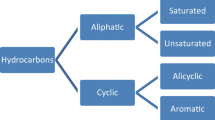Abstract
Background, Aims and Scope
An out-of-service oil distribution and storage station (ODSS), which operated from 1966 to 2000 in Mexico, is contaminated mainly by gasoline and diesel, showing the presence of methyl-tert-butyl-ether, benzene, toluene, ethyl benzene, and xylenes. Nine of the 16 polycyclic aromatic hydrocarbons were found, as well as Fe, Pb, V, and Zn. The health risk assessment suggested the necessity of reducing of three PAHs [benzo(a)anthracene, benzo(a)pyrene, and benzo-(b)fluoranthene], and vanadium. The aim of this work is to show that soil washing (on-site) and biopiles are excellent remediation methodologies to treat soils contaminated with petroleum derivates and metals. Applying them, it is possible to reach the goal value of 2,000 mg TPH/kg in a few months, as requested by Mexican legislation.
Methods
More than 140 m3 were excavated from the ODSS. Three soil-washing dishes were built. 1540 m3 were treated by soil washing using a nonionic surfactant. A 100 m3 biopile was built to study the system capabilities in the biodegradation of around 4,500 mg/kg of TPH using the autochthonous microflora.
Results and Discussion
The soil washing, average TPH-removal value was 83%, but values up to ca. 93% were observed. Removal values resulted in a function of the TPH initial values. Biopile (100 m3) worked during 66 days, reaching a TPH-removal value of 85%. At the end of the processes, no PAHs were detected. The contaminated soil was treated successfully, reaching the legislation limits (TPH values under 2,000 mg/kg, and a significant reduction in PAH concentrations).
Conclusion and Recommendation
Both systems are suitable for remediation purposes, achieving high removal efficiencies at short and medium stages. It is highly recommended to proceed with soil washing studies, identifying new products, and mixtures, which could reduce costs and assure optimum operation.
Similar content being viewed by others
References
CONAGUA (2000): htpp://smn/cna/gob.mx/productos/normales.html
Chineau C, Yepremian C, Vidalie J, Decreux J, Ballerini D (2003): Bioremediation of a crude oil-polluted soil: Biodegradation, leaching and toxicity assessments. Water, Air and Soil Pollution 144 (1-4) 419–440
Eriksson M, Dalhammar G, Borg-Karlson AK (2000): Biological degradation of selected hydrocarbons in a PAH/creosote contaminated soil from a gas work site. Applied Microbiology and Biotechnology 53, 619–626
Fahnestock FM (1998): Biopile design. Operation and maintenance handbook for treating hydrocarbon-contaminated soils. Battelle press, USA
Gogoi BK, Dutta NN, Goswami P, Mohan KTR (2003): A case of bioremediation of petroleum-hydrocarbon contaminated soil at a crude spill site. Advances in Environmental Research. Submitted
Guerin TF (2000): The differential removal of aged polycyclic aromatic hydrocarbons from soil during bioremediation. ESPR — Environ Sci & Pollut Res 7, 1–8
Iturbe R, Castro A, Madrigal I (1998): Soil and aquifer remediation techniques. (In Spanish). Instituto de Ingeniería. UNAM. Series del Instituto de Ingeniería (No. 612) México. ISSN 0185—2345, 97 pp
Iturbe R, Chavez C, Flores C (2001): Biopiles: A remediation option for soils contaminated by hydrocarbons. XV International Conference on Soil Mechanics. Turkey
Iturbe R, Flores RM, Torres LG (2003): Subsoil contaminated by hydrocarbons in an out of service oil distribution and storage station in Zacatecas, Mexico. Environmental Geology 44, 608–620
Iturbe R, Flores C, Chávez C, Ramírez A, Torres LG (2004):In-situ flushing of contaminated soils from a refinery: Organic compounds and metal removals. Remediation Journal 14 (2) 141–152
Jorgensen KS, Puustinen J, Sourtii AM (2000): Bioremediation of petroleum hydrocarbon-contaminated soil by composting in biopiles. Environmental Pollution 107, 245–254
Li G, W. Huang, DN Lerner, Zhang X (2000): Enrichment of degrading microbes and bioremediation of petrochemical contaminants in polluted soil. Water Research. 34 (15) 3845–3853
Lowe DF, Oubre CL, Ward CH (1999): Surfactants and Cosolvents for NAPL Remediation. Lewis Publishers, USA
Mulligan CN, Yong RN, Gibbs BF (2001): Surfactant-enhanced remediation of contaminated soil: A review. Engineering Geology 60, 371–380
Pollard SJT, Whittaker M, Risden GC (1999): The fate of heavy oil wastes in microcosms I: a performance assessment of biotransformation indices. The Science of the Total Environment 226, 1–22
Seklemova E, Pavlova A, Kovacheva K (2001): Biostimulation-based bioremediation of diesel fuel: field demonstration. Biodegradation 12, 311–316
Sharma SL, Pant A (2000): Biodegradation and conversion of alkanes and crude oil by a marineRhodococcus sp. Biodegradation 11, 289–294
Simpkin T, Sale T, Kueper B, Pitts M, Wyatt K (1999): Surfactants and cosolvents for NAPL remediation. A technology manual. Lewis Publishers, USA
Torres LG, Orantes JL, Iturbe R (2003): Three surfactants CMC and diesel removal efficiencies from sandy soils highly contaminated. Environmental Geosciences 10 (1) 28–36
Author information
Authors and Affiliations
Corresponding author
Rights and permissions
About this article
Cite this article
Iturbe, R., Flores, C., Chavez, C. et al. Remediation of contaminated soil using soil washing and biopile methodologies at a field level. J Soils & Sediments 4, 115–122 (2004). https://doi.org/10.1007/BF02991055
Received:
Accepted:
Issue Date:
DOI: https://doi.org/10.1007/BF02991055




